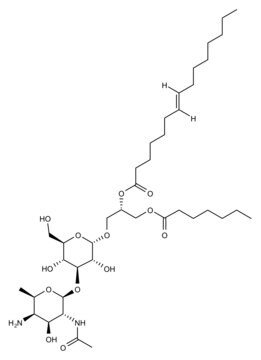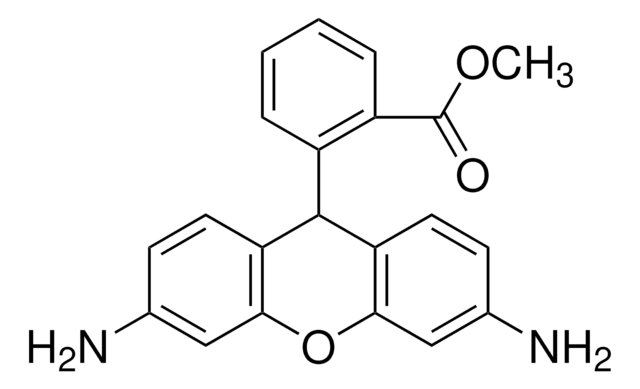About This Item
Kod UNSPSC:
41116133
NACRES:
NA.41
application:
citations:
15
Polecane produkty
Formularz
lyophilized
Poziom jakości
producent / nazwa handlowa
Calbiochem®
warunki przechowywania
OK to freeze
Warunki transportu
ambient
temp. przechowywania
2-8°C
Opis ogólny
Formalin-fixed and heat-killed Staphylococcus aureus cells bearing protein A that bind to the Fc portion of human IgG subclasses 1, 2, and 4, and to IgG from other species (binding capacity: ≥2 mg human IgG/100 mg cells). Used for many purposes, including radioimmunoassays, enzyme immunoassays, agglutination, and immunoprecipitation of antigens. PANSORBIN also stimulates B-lymphocyte production and inhibits neoplasm growth. Lyophilized from preparations of Cat. No. 507858. Note: size of 5 g or 1 g refers to the wet cell weight.
Lyophilized from preparations of Cat. No. 507858. Note: size of 5 g or 1 g refers to the wet cell weight.
Opakowanie
Packaged under inert gas
Ostrzeżenie
Toxicity: Standard Handling (A)
Postać fizyczna
Lyophilized from PBS, 0.1% NaN₃.
Rekonstytucja
Following reconstitution, aliquot and refrigerate (4°C). Stock solutions are stable for up to 1 month at 4°C.
Reconstitute in sterile distilled H₂O.
Reconstitution with 10 ml sterile dH₂O yields a 10% (w/v) cell suspension.
Inne uwagi
Kierszenbaum, F., et al. 1991. Immunology74, 317.
Meikle, P.J., et al. 1991. J. Biol. Chem.266, 22569.
Ezaki, O., et al. 1989. Biochem. Biophys. Res. Commun.159, 1368.
Murakami, H., et al. 1988. Biochem. J.256, 917.
Kessler, S.W. 1975. J. Immunol.115, 1617.
Meikle, P.J., et al. 1991. J. Biol. Chem.266, 22569.
Ezaki, O., et al. 1989. Biochem. Biophys. Res. Commun.159, 1368.
Murakami, H., et al. 1988. Biochem. J.256, 917.
Kessler, S.W. 1975. J. Immunol.115, 1617.
Informacje prawne
CALBIOCHEM is a registered trademark of Merck KGaA, Darmstadt, Germany
PANSORBIN is a registered trademark of Merck KGaA, Darmstadt, Germany
Ta strona może zawierać tekst przetłumaczony maszynowo.
Hasło ostrzegawcze
Danger
Zwroty wskazujące rodzaj zagrożenia
Zwroty wskazujące środki ostrożności
Klasyfikacja zagrożeń
Acute Tox. 3 Oral - Aquatic Chronic 3
Kod klasy składowania
6.1C - Combustible acute toxic Cat.3 / toxic compounds or compounds which causing chronic effects
Klasa zagrożenia wodnego (WGK)
WGK 3
Certyfikaty analizy (CoA)
Poszukaj Certyfikaty analizy (CoA), wpisując numer partii/serii produktów. Numery serii i partii można znaleźć na etykiecie produktu po słowach „seria” lub „partia”.
Masz już ten produkt?
Dokumenty związane z niedawno zakupionymi produktami zostały zamieszczone w Bibliotece dokumentów.
Eriko Kudo et al.
International journal of molecular medicine, 41(4), 2366-2374 (2018-01-18)
Copper metabolism Murr1 domain containing 1 (COMMD1) has multiple functions in the regulation of protein stability at the plasma membrane and in the cytoplasm. However, the regulation of COMMD1 transcriptional has remained to be elucidated. In the present study, the 5'‑flanking
Deborah L Burkhart et al.
PLoS genetics, 6(6), e1001003-e1001003 (2010-06-30)
The retinoblastoma tumor suppressor (Rb) is a potent and ubiquitously expressed cell cycle regulator, but patients with a germline Rb mutation develop a very specific tumor spectrum. This surprising observation raises the possibility that mechanisms that compensate for loss of
Jenny Hsu et al.
Nature communications, 10(1), 2939-2939 (2019-07-05)
E2F transcription factors are central regulators of cell division and cell fate decisions. E2F4 often represents the predominant E2F activity in cells. E2F4 is a transcriptional repressor implicated in cell cycle arrest and whose repressive activity depends on its interaction
Zuyao Ni et al.
Journal of immunology (Baltimore, Md. : 1950), 178(1), 345-351 (2006-12-22)
IL-6 is an immunoregulatory cytokine with multiple functions in hemopoiesis, proliferation, and tumorigenesis. IL-6 triggers phosphorylation, dimerization, and nuclear translocation of STAT3, which binds to target promoters and activates transcription. Brahma-related gene 1 (BRG1), the enzymatic engine of the yeast-mating
Hong Peng et al.
Chemico-biological interactions, 243, 82-90 (2015-11-21)
Five mouse anti-human butyrylcholinesterase (BChE) monoclonal antibodies bind tightly to native human BChE with nanomolar dissociation constants. Pairing analysis in the Octet system identified the monoclonal antibodies that bind to overlapping and independent epitopes on human BChE. The nucleotide and
Nasz zespół naukowców ma doświadczenie we wszystkich obszarach badań, w tym w naukach przyrodniczych, materiałoznawstwie, syntezie chemicznej, chromatografii, analityce i wielu innych dziedzinach.
Skontaktuj się z zespołem ds. pomocy technicznej






